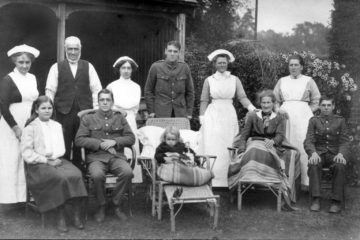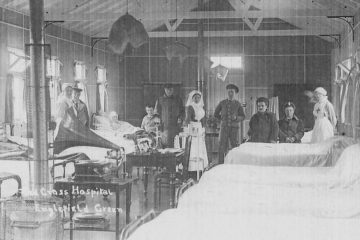Read part one here

If the “Daddy, what did you do in the Great War?” poster did not encourage, or in fact, shame, enough men to enlist, then other ways of persuasion were used, and soon, women began to appear in recruitment posters. E.V Kealey’s painting for the PRC, “Women of Britain Say –‘Go!’” (fig. e), from May 1915, clearly sends the message to women that they should encourage their sons, husbands, brothers, and sweethearts, to join the war effort as it is their duty. Not only is it telling women that they can play their part in this war by being strong but also, despite their fears, they must encourage their men to go to war. The poster also lets the men, who have not yet volunteered, know that their mothers, wives and daughters, want them to ‘Go!’. The poster depicts one such brave woman, looking on as her men march away – she is a pillar of strength to the young girl and boy beside her.

John Bull, a fictional cartoon character portraying an honest, solid farmer figure usually accompanied by a bulldog, was invented by Sir John Tenniel in the 18th century and published in the Punch magazine. In the 1916 the poster “Who’s absent – Is it you?” (fig. b), John Bull represents the ‘people’ in a Union Jack waistcoat and has his index finger pointing towards the reader. The tactic used here, and also in “Your Country Needs You”, is called appellation. It calls to the reader, “who feels that he or she is an agent, acting out freely the dictates of a coherent ego.”[1] The ‘hailing effect’, as it is also known, is designed to affect the reader on a personal and intimate level, calling to them as if it is only they, ‘an agent’ of war, who can save this country. The soldiers in the background of “Who’s absent – Is it you?” are those who have already joined, and are now waiting for “you”. This poster is designed to attack a man’s sense of duty, and make him feel ashamed if he had not yet volunteered.
In 1917, Lord Northcliffe persuaded the Prime Minister Lloyd George, to allow him to establish a special Propaganda Department in Crewe House. Its purpose was to bring together all of the propaganda branches in other governmental departments, which up until then had been distributing their own information, and take sole control of propaganda in a single centralised department from then on. It was a great success at the time and “Great Britain emerged from World War 1 with the doubtful distinction of having employed propaganda better than any other nation.”[2]
Those making propaganda had to carefully consider whom they were ‘advertising’ to; their target audience needed to be very clear in order to have the most successful outcome. It was noted in a report on Red Government Posters by Mass Observation, that for every two women who looked at a poster, three men looked.[3] This seemed to indicate that women were more difficult to attract than men, so different kinds of tactics would need to be employed. Noticing that “words, as opposed to pictures, appeal more to men than women”,[4] meant that a striking image, and not a flood of text, would be required if women were to take any notice. This image usually took the form of an alluring female figure, as for many women, “their image has been powerful and inspiring, offering a sense of new possibilities… and action.”[5]
However, as time went on, many people started to speculate that propaganda was used to control the British public. “Memoirs and exposés published in Britain, Germany, and the United States in the early 1920s convey the impressions that the citizens of each nation had been duped and manipulated by propaganda.”[6] Harold Lasswell, author of Propaganda Techniques in the World War (1927) seems to have captured the public opinion when he describes the Allied propaganda as “All-lies”.[7] It seemed that, despite emerging as the victors of the Great War, the Great British public were unhappy with the use of propaganda on the home front. Even Lasswell himself stated that, “a nation with a high morale is capable of performing the tasks laid upon it…”[8] So how else would this morale remain high, or men recruited into the army, or women brought into the factories?
The word ‘propaganda’ has got special war associations. And these are largely due to British activity in the last war. People very competent to judge, like Lundendorf, Hindenburg and Goering have ascribed a large share of our 1918 victory to our propaganda…[9]
[1] Judith Williamson, Decoding Advertisements, Marion Boyars, London, 1978, p.40
[2] Anthony Rhodes, Propaganda, The Art of Persuasion: World War II, Angus & Robertson Publishers, 1976, p.107
[3] M-O A: FR ‘Government Posters in Wartime’, p.10
[4] Ibid.
[5] Ed. Rosemary Betterton, Looking On, Images of Femininity in the Visual Arts and Media, Pandora, London, 1987, p. 9
[6] Mariel Grant, Propaganda and the Role of State in Inter-War Britain, Oxford University Press, 1994, p.12
[7] Harold D. Lasswell, Propaganda Techniques in the World War, Mackays Ltd, Chatham, 1927, p.3
[8] Harold D. Lasswell, Propaganda Techniques in the World War, Mackays Ltd, Chatham, 1927, p.8
[9] M-O A: TC Propaganda/Morale, 2/C, What is Propaganda? p.1



0 Comments